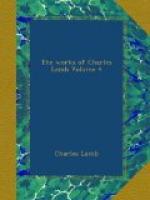a sense of their presence? We might as well laugh
under a consciousness of the principle of Evil himself
being truly and really present with us. But attempt
to bring these things on to a stage, and you turn them
instantly into so many old women, that men and children
are to laugh at. Contrary to the old saying,
that “seeing is believing,” the sight
actually destroys the faith; and the mirth in which
we indulge at their expense, when we see these creatures
upon a stage, seems to be a sort of indemnification
which we make to ourselves for the terror which they
put us in when reading made them an object of belief,—when
we surrendered up our reason to the poet, as children
to their nurses and their elders; and we laugh at our
fears, as children, who thought they saw something
in the dark, triumph when the bringing in of a candle
discovers the vanity of their fears. For this
exposure of supernatural agents upon a stage is truly
bringing in a candle to expose their own delusiveness.
It is the solitary taper and the book that generates
a faith in these terrors: a ghost by chandelier
light, and in good company, deceives no spectators,—a
ghost that can be measured by the eye, and his human
dimensions made out at leisure. The sight of
a well-lighted house, and a well-dressed audience,
shall arm the most nervous child against any apprehensions:
as Tom Brown says of the impenetrable skin of Achilles
with his impenetrable armor over it, “Bully
Dawson would have fought the devil with such advantages.”
Much has been said, and deservedly, in reprobation
of the vile mixture which Dryden has thrown into the
Tempest: doubtless, without some such vicious
alloy, the impure ears of that age would never have
sat out to hear so much innocence of love as is contained
in the sweet courtship of Ferdinand and Miranda.
But is the tempest of Shakspeare at all a subject
for stage-representation? It is one thing to
read of an enchanter, and to believe the wondrous tale
while we are reading it; but to have a conjurer brought
before us in his conjuring gown, with his spirits
about him, which none but himself and some hundred
of favored spectators before the curtain are supposed
to see, involves such a quantity of the hateful
incredible, that all our reverence for the author
cannot hinder us from perceiving such gross attempts
upon the senses to be in the highest degree childish
and inefficient. Spirits and fairies cannot be
represented, they cannot even be painted,—they
can only be believed. But the elaborate and anxious
provision of scenery, which the luxury of the age
demands, in these cases works a quite contrary effect
to what is intended. That which in comedy, or
plays of familiar life, adds so much to the life of
the imitation, in plays which appeal to the higher
faculties positively destroys the illusion which it
is introduced to aid. A parlor or a drawing-room,—a
library opening into a garden—a garden
with an alcove in it,—a street, or the




